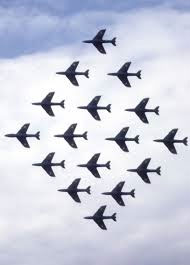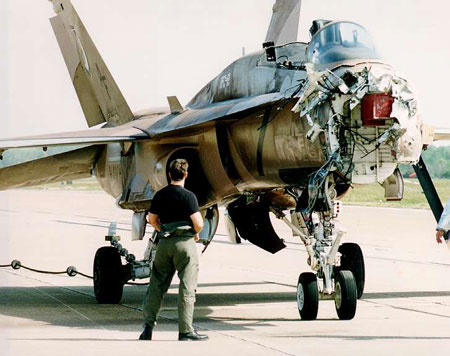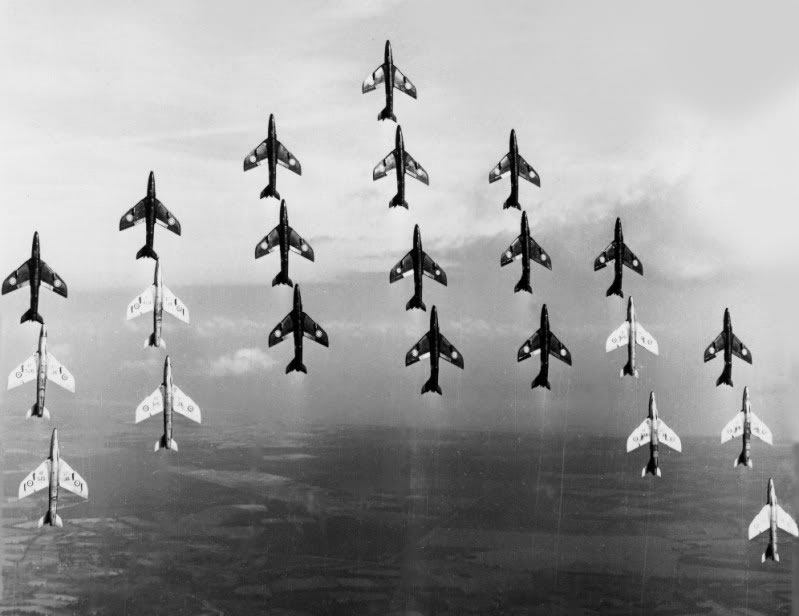Formation Flying and "The Worst Day Ever"
It’s just about summer, and the only thing better than flying your warbird on a sunny day is flying your warbird while next to another warbird on a sunny day. So we added this piece on formation flying. Keep in mind the FARs’ fairly simple statements on formation flying:
- § 91.111 Operating near other aircraft.
o No person may operate an aircraft so close to another aircraft as to create a collision hazard.
o No person may operate an aircraft in formation flight except by arrangement with the pilot in command of each aircraft in the formation.
- No person may operate an aircraft, carrying passengers for hire, in formation flight.
For a deeper and serious look, and from the people who have a vocational reason to do so, we had this following piece written by a person
This was forwarded to me, but every time I read and reread Neptunus Lex, I realize the simply staggering intellect and gift that this great pilot had for describing complex pilot concepts in a beautiful way. Reading it, you even see how a fast jet pilot trained to think and react, and you learn to appreciate the inherent axiomatic foundation of all safety in operations: “Brief the flight and fly the brief.”
That’s all. Deviate from that and you allow randomness and casual chance to play games with your terrestrial timeline. Neptunus Lex and his prose introduced me to a whole new world, and I will add some of the writings I have saved from him over the next few months. Every time I sip a Guinness, I think of fighter pilots, and especially Captain Carroll “Lex” LeFon, U.S. Navy (retired), and thank his spirit for his service. He was one of the greatest ones. – Joseph Scheil
The Worst Day Ever
I don’t tell this story very often. Although the events inside it happened almost 12 years ago, the memory is still fresh, and still painful.
Over the years I’ve told it to two ready rooms, both by way of instruction – a kind of “been there, seen that” – in order to prevent anything like it from ever happening again. But it’s not one of those sea stories you tell over a beer, among friends. It’s a sad story. Maybe I post this one. Maybe I don’t.
The story is not really about me, but about Terry.
Terry was a senior lieutenant in my adversary squadron in Key West, Florida, back in the ’90s. He was the kind of guy you’d like your son to grow into, your daughter to marry. He was a superb pilot, in a squadron full of talent – he’d won honors as the Atlantic Fleet Pilot of the Year before showing up at Key West. A superb athlete, Terry had captained his high school football team, who went on to win the state championship.
He drank Guinness (for strength!), was a raconteur, and friendly to all. His sailors worshipped him, his peers loved him, and his seniors valued him. We were not very close socially; he was single and did the single guy things in Key West. I was married, raising a son, expecting a daughter. We were in different places in our lives, but I respected him immensely.
Terry was one of my first instructors after I left the high-tech and afterburning F/A-18 for the subsonic A-4 Skyhawk – the “Scooter” – a nimble jet but not at all automated. There were no flight control computers to help Mongo point nose; it was all airmanship:
5g turn nose high, hook the slats out, flaps twenty degrees, trim up 7-8 units, rudder, rudder, rudder, throttle chop, throttle up, flaps half, 15 units AOA, hold the slats out, hold them! “Pipper’s on, guns kill, knock it off.”
Terry had flown A-7s, mud movers, and attack jets – and I was a Hornet pilot; I had flown fighters. What could Terry teach me about fighting I didn’t already know?
Volumes, as it turned out. Starting with humility. Which he treated me to in heroic doses over time. Man, he was good…Lex is dead, set up another.
I’ve been in the squadron for a while now, it’s Friday, and the FA-18 training squadron is in town. We’re suiting up for a 2v2 DACT (dissimilar air combat training) hop. I just started flying the F-16, and Terry has a flight tomorrow that I’m lusting after. When I ask him if he’d let me take his hop the next day, he told me, “ask me tomorrow.” He was single; he had a big night planned for downtown Key West. A night of chaos potentially – anything could happen. But you didn’t give up F-16 hops for free.
We’d briefed a mass administrative brief (all the several fighters, all the bogeys) in one room. For simplicity’s sake, the instructor pilot briefing the gaggle closes by saying, “We’ll return to the field in similar sections,” i.e. by squadron, by two-ship. The fighters will come back together, and the bandits will come back together. Simple enough.
Terry’s flying the F-5 today, and I’m in the Scooter. The F-5 had a much higher approach speed than any Navy jet, higher even than the F-16. In our squadron, it was “standard” for the F-5 to come in on the left wing for a wedge or diamond break. He’d break left first, the rest of the flight would follow after him. This would keep the faster F-5 from collapsing the interval on final approach, getting too close to the jet ahead of him. It was “standard” because that was what we always did. But it was not in the written SOP, or standard operating procedures. SOPs are written by each squadron, filling in the holes in higher guidance on things like coming back to the field in formation and landing.
We didn’t do wedge breaks on the West Coast, where I’d come from – there had been a midair collision several years previously when the lead broke into his wingman. I’d been somewhat surprised to learn they were still being done on the East Coast. But hey, we briefed it carefully in every squadron brief; it was what we did. It was standard.
After two hacks fighting on the range, the fighter lead was bingo, or out of fuel. He headed home. Terry, my lead, ran low on the third run and cleared the fight. I ended up in a protracted engagement with the fighter wingman, no “nugget” or new guy but an experienced, mid-grade aviator, transitioning from the A-7 to the F/A-18. We fought to a draw, and as he was now out of gas, he started to head home.
“Join on my wing?” he asked. I said sure. He was senior to me, also a West Coast guy, and it’s always considered good form to go home with someone – one less bit of traffic to worry about going back to the field. And there was mutual support in case something went wrong along the way. You never knew.
As we headed back to the field, Terry joined on the left. He’d been hanging out, clear of the fight, saving gas. We were now in a wedge formation, with the F/A-18 in the center, leading, me on the right wing and Terry on the left – where the F-5s would break formation from to join downwind and land. Standard.
There was a traffic call from the tower, prior to the initial, about someone lifting off from Key West International. F-5s and A-4s only had one radio; this we tuned to tower frequency, and you didn’t chatter on tower – it was a control freq. F/A-18s had two radios, but since we only had one, we couldn’t share the radar situational awareness the F/A-18 pilot gained. Terry and I drifted out a bit, ready to react, scanning the area visually. When the traffic was no longer a factor, we tightened up the formation, looking good for the overhead.
The F/A-18 lead looked left toward Terry, looked right toward me, and made a quick series of nonstandard hand signals. They looked to me like “Break from wedge, F-5 first,” which is what I expected to see. A standard procedure, even if it wasn’t SOP.
It also wasn’t what we’d briefed before the flight: “Return to the field in similar sections.” Seconds later, overhead the field, we’re looking good. We’re looking great! Nice, tight formation, three dissimilar jets. The lead, in the center, looking straight ahead, gives me the goodbye-kiss signal, meaning he was breaking away, breaking left.
I turned my head fractionally to the left – there was Terry, still on the left wing. He hadn’t left the formation yet. The picture doesn’t sync, and I’ve got less than one second to figure it out. It’s called cognitive dissonance: motivational state produced by inconsistencies between simultaneously held cognitions or between a cognition and behavior; e.g. smoking enjoyment and believing smoking is harmful are dissonant.
Or between “my lead is breaking left, and our wingman is still there, on his left wing. On the radio, I got out a muffled, “No, no!” It wasn’t in time—in seeming slow motion I see the F/A-18 bank away from me, toward Terry, who banks away slightly, instinctively. Startled? Certainly. Terrified? Perhaps. Aware of impending mortality? Can’t know.
The F/A-18 starts his hard turn. His left wing knocks the F-5’s nose and canopy off, 40 feet away from me. The F/A-18 tail hits the F-5 empennage and stabilator. There is no sound, none at all, but my engine in my ears, and the sound of my scream in the oxygen mask.
In the now open cockpit, I see Terry slumped—I see his yellow t-shirt, I see the hairs on his chest above the shirt. And then the sight is removed, as his jet spirals down to the waiting ground, 800 feet below.
“Eject, eject, EJECT!” I scream. But he doesn’t.
And in slow motion, his jet became a black, grey, and red flower, a blossom planted on the runway intersection, and just like that, Terry was gone.
I had to join on the crippled F/A-18, get him on deck. No telling how long he could stay controllable in that configuration, bleeding hydraulic fluid. He trapped on the last available runway, and I had to land somewhere else. Key West International, not enough gas to go anywhere else. So that’s where I went, and I used all of the 4,300-foot runway, crack to crack, to stop the jet, barely, by the end. Shut her down, climbed out and cried until the sobs turned to shudders.

“Is it bad?” asked the civilian linesman.
It was bad.
I got picked up by the squadron PAO, was driven back in silence to the squadron, started giving statements to the mishap board when I arrived.
The F/A-18 guy had assumed Terry would cross under to the right, just like they did on the West Coast. Terry had assumed we’d break from wedge, just like we always did. Such little, small things to assume. Such enormous consequences.
We’d briefed one thing, unthinkingly, and done another, unthinkingly. Just that one time, just that little thing. It was all so meaningless – we weren’t at war, the republic wasn’t at risk. Nothing we had done that day, certainly not coming back to land, had been worth dying for.
The F/A-18 guy never recovered his confidence. Don’t know what he’s doing now.
Neptunus Lex
Fighter Pilot Captain Carroll “Lex” LeFon, USN (Ret.) continued to fly after his time in the USN and achieved the in my mind perhaps the ultimate retirement job, flying high performance fighter planes in mock combat drills for a company that worked all over the world. The warbird he was flying was a civilian jet, and he was a civilian pilot, albeit one with the best of training, and based on his resume, he mastered each stage and continually was selected for greater things. His writing allows some of us to have an insight into a world that social convention and technical virtuosity has kept hidden. He is missed.

